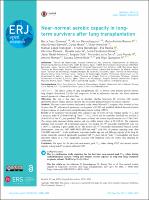| dc.contributor | Vall d'Hebron Barcelona Hospital Campus |
| dc.contributor.author | Saez Gimenez, Berta |
| dc.contributor.author | Barrecheguren Fernández, Miriam |
| dc.contributor.author | Ramon Belmonte, Maria Antonia |
| dc.contributor.author | Gómez Garrido, Alba |
| dc.contributor.author | Monforte Torres, Victor |
| dc.contributor.author | Berastegui Garcia, Cristina |
| dc.contributor.author | Revilla Lopez, Eva Maria |
| dc.contributor.author | Román Broto, Antonio |
| dc.contributor.author | Gómez Olles, Susana |
| dc.contributor.author | Ojanguren Arranz, Iñigo |
| dc.contributor.author | Romero Mesones, Christian Eduardo |
| dc.contributor.author | López Meseguer, Manuel |
| dc.contributor.author | Bravo Masgoret, Carles |
| dc.date.accessioned | 2021-05-21T11:16:00Z |
| dc.date.available | 2021-05-21T11:16:00Z |
| dc.date.issued | 2021-02-01 |
| dc.identifier.citation | Saez-Gimenez B, Barrecheguren M, Ramon MA, Gomez-Garrido A, Bravo C, Monforte V, et al. Near-normal aerobic capacity in long-term survivors after lung transplantation. ERJ Open Res. 2021 Feb 1;7(1):00381-2020. |
| dc.identifier.issn | 2312-0541 |
| dc.identifier.uri | https://hdl.handle.net/11351/5967 |
| dc.description | Trasplantaments de pulmó; Supervivents; Capacitat aeròbica |
| dc.description.abstract | The clinical course of lung transplantation (LT) is diverse: some patients present chronic lung allograft dysfunction (CLAD) and progressive decline in pulmonary function, but others maintain normal spirometric values and active lives. Objectives The aim of this study was to elucidate whether long-term LT survivors with normal spirometry achieve normal exercise capacity, and to identify predictive factors of exercise capacity. Methods This was a cross-sectional multicentre study, where bilateral LT recipients who survived at least 10 years after LT, with normal spirometry, no diagnosis of CLAD and modified Medical Research Council dyspnoea degree ≤2 underwent cardiopulmonary exercise testing (CPET). Results 28 LT recipients were included with a mean±sd age of 48.7±13.6 years. Oxygen uptake (V′O2) had a mean±sd value of 21.49±6.68 mL·kg−1·min−1 (75.24±15.6%) and the anaerobic threshold was reached at 48.6±10.1% of the V′O2max predicted. The mean±sd heart rate reserve at peak exercise was 17.56±13.6%. The oxygen pulse increased during exercise and was within normal values at 90.5±19.4%. The respiratory exchange ratio exceeded 1.19 at maximum exercise. The median (25–75th percentile) EuroQol-5D score was 1 (0.95–1), indicating a good quality of life. The median (25–75th percentile) International Physical Activity Questionnaire score was 5497 (4007–9832) MET-min·week−1 with 89% of patients reporting more than 1500 MET-min·week−1. In the multivariate regression models, age, sex and diffusing capacity of the lung for carbon monoxide remained significantly associated with V′O2max (mL·kg−1·min−1); haemoglobin and forced expiratory volume in 1 s were significantly associated with maximum work rate (watts), after adjusting for confounders. Conclusion We report for the first time near-normal peak V′O2 values during CPET and normal exercise capacity in long-term LT recipients without CLAD. |
| dc.description.sponsorship | Support statement: This study was financed by Instituto de Salud Carlos III (PI13/01076); the European Regional Development Fund (FEDER), FUCAP, Astellas, Novartis and Chiesi. Funding information for this article has been deposited with the Crossref Funder Registry. |
| dc.description.sponsorship | Ojanguren is a researcher supported by the “Pla Estratègic de Recerca i Innovació en Salut (PERIS)” 2016–2020 (SLT008/18/00108;G60594009). |
| dc.language.iso | eng |
| dc.publisher | European Respiratory Society |
| dc.relation.ispartofseries | ERJ Open Research;7(1) |
| dc.rights | Attribution-NonCommercial 4.0 International |
| dc.rights.uri | http://creativecommons.org/licenses/by-nc/4.0/ |
| dc.source | Scientia |
| dc.subject | Pulmons - Trasplantació |
| dc.subject | Espirometria |
| dc.subject | Exercici |
| dc.subject.mesh | Lung Transplantation |
| dc.subject.mesh | Spirometry |
| dc.subject.mesh | Exercise |
| dc.title | Near-normal aerobic capacity in long-term survivors after lung transplantation |
| dc.type | info:eu-repo/semantics/article |
| dc.identifier.doi | 10.1183/23120541.00381-2020 |
| dc.subject.decs | trasplante de pulmón |
| dc.subject.decs | espirometría |
| dc.subject.decs | ejercicio físico |
| dc.relation.publishversion | https://doi.org/10.1183/23120541.00381-2020 |
| dc.type.version | info:eu-repo/semantics/publishedVersion |
| dc.audience | Professionals |
| dc.contributor.organismes | Institut Català de la Salut |
| dc.contributor.authoraffiliation | [Saez-Gimenez B, Barrecheguren M, López-Meseguer M, Berastegui C, Revilla E, Romero C] Servei de Pneumologia, Vall d’Hebron Hospital Universitari, Barcelona, Spain. Departament de Medicina, Universitat Autònoma de Barcelona, Bellaterra, Spain. [Ramon MA, Bravo C, Monforte V, Roman A, Gómez-Ollés S, Ojanguren I] Servei de Pneumologia, Vall d’Hebron Hospital Universitari, Barcelona, Spain. Departament de Medicina, Universitat Autònoma de Barcelona, Bellaterra, Spain. CIBER Enfermedades Respiratorias (CIBERES), Barcelona, Spain. [Gomez-Garrido A] Servei de Rehabilitació, Vall d’Hebron Hospital Universitari, Barcelona, Spain |
| dc.identifier.pmid | 33569504 |
| dc.identifier.wos | 000625441800018 |
| dc.relation.projectid | info:eu-repo/grantAgreement/ES/PE2013-2016/PI13%2F01076 |
| dc.relation.projectid | info:eu-repo/grantAgreement/ES/PERIS2016-2020/SLT008%2F18%2F00108 |
| dc.rights.accessrights | info:eu-repo/semantics/openAccess |

